Cool and relatively dry overall, wetter in the Northwest
- Overall (using the Island of Ireland dataset*), the average national temperature for summer 2024 was 14.50 °C, which is 0.28 °C below the most recent 1991-2020 long-term average (LTA) and 0.19 °C below the 1981-2010 LTA. However, average national temperature for summer 2024 is 0.25 °C above the 1961-1990 LTA.
- Summer 2024 was the coldest Summer in 9 years, since Summer 2015, when the average national temperature was 13.87 °C.
- The warmest summer was in 1995 with 16.11 °C and the coldest summer was in 1912 with 12.65 °C (112 years ago). Summer 2024 is ranked 52nd warmest (in 125 year record).
- Provisional gridded rainfall data suggests suggests summer 2024 saw an average rainfall total of 237 mm, which was 86 % of the 1981-2010 LTA and 39% drier than summer 2023.
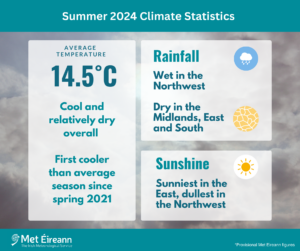
Summer 2024 Climate Statistics
Summer 2024 was cool and relatively dry overall. Several arctic blasts from the north in early June set the scene for what turned out to be the first cooler than average season since spring 2021 (13 seasons ago). A zonal jet stream (west to east), directly over or close to Ireland for most of the season, blocked warm air masses to the south from pushing north over Ireland. On the few occasions when the jet stream became more meridional (north to south), such as in early June and early July, its orientation favoured high pressure building north over the mid-Atlantic, which allowed cool Polar maritime air masses to move in over Ireland from the north or northwest.
June and July were dry and cool months. A northerly airflow from the Arctic dominated the first half of the June, while Atlantic westerlies took control for the second half of the month. July saw a cool north-westerly for the first third of the month followed by a gradual warming as high pressure to the west moved east. The final third of the month began with low pressure to the north in control before high pressure built to the south. August saw low pressure to the north and northwest and high pressure to the south and southeast for most of the month. This setup brought the bulk of the rainfall to the West and Northwest of the country and kept these regions cool, while the South and East experienced a drier and warmer month.
Rainfall: Wet in the Northwest, dry in the Midlands, South and East
The majority of seasonal rainfall totals across the country were below their 1981-2010 Long-Term Average (LTA). Percentage of seasonal rainfall values ranged from 53% (104.7 mm) at Dublin Airport, Co Dublin (its driest summer since 2018) to 136% (344.3 mm) at Belmullet, Co Mayo. Seasonal rainfall totals ranged from 104.7mm (53% of its LTA) at Dublin Airport, Co Dublin to 419.0 mm (130% of its LTA) at Newport, Co Mayo. The season’s wettest day was also recorded at Newport, Co Mayo with 34.6 mm on Sunday 4th August. The number of rain days* ranged from 43 days at Roche’s Point, Co Cork to 73 days at Knock Airport, Co Mayo. The number of wet days* ranged from 25 days at Oak Park, Co Carlow to 57 days at Newport, Co Mayo. The number of very wet days* ranged from zero days at Moore Park, Co Cork to 18 days at Newport, Co Mayo.
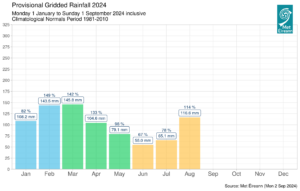
Provisional monthly gridded 2024 rainfall anomalies so far (% of 1981-2010 LTA) together with monthly rainfall totals in millimeters (summer months in orange)
Temperature: Below average nearly everywhere, coolest in the Northwest
Nearly all mean air temperatures were below their LTA for the season. Deviations from mean air temperature for the season ranged from -1.0 °C (13.4 °C mean temperature) at Markree, Co Sligo to 0.2 °C (15.0 °C mean temperature) at Phoenix Park, Co Dublin. Mean air temperatures ranged from 12.8 °C (0.5 °C below its LTA) at Knock Airport, Co Mayo to 15.0 °C at both Shannon Airport, Co Clare (0.7°C below its LTA) and Phoenix Park, Co Dublin (0.2°C above its LTA) (the coldest summer since 2015 at both stations). The season’s highest temperature was reported at Phoenix Park, Co Dublin on Monday 24th June with a temperature of 26.6 °C (the lowest maximum summer temperature for Ireland since 2015). The season’s lowest minimum air temperature was recorded on Wednesday 12th June at Claremorris, Co Mayo with 1.8 °C while the lowest grass minimum was -1.4 °C reported at Mullingar, Co Westmeath on Tuesday 11th June. There was no air frost reported this season. Less than half of stations reported ground frost. The number of days with ground frost ranged from zero days at a few stations to 5 days at Mullingar, Co Westmeath. Most stations had their coldest summer since 2015.
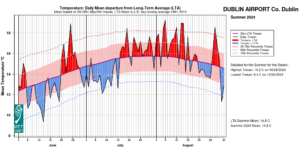
Dublin Airport, Co Dublin Temperature: Daily mean departure from LTA for Summer 2024 based on 09-09hr Max/Min values.
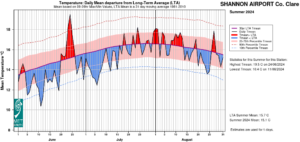
Shannon Airport, Co Clare Temperature: Daily mean departure from LTA for Summer 2024 based on 09-09hr Max/Min values.
Sunshine: Sunniest in the East
Sunshine values varied across the country. Percentage of seasonal sunshine values ranged from 107% (seasonal sunshine total of 467.6 hours) at Shannon Airport, Co Clare to 111% (the season’s highest seasonal sunshine total of 514.1 hours) at Casement Aerodrome, Co Dublin. Seasonal sunshine totals were lowest at Malin Head, Co Donegal with 391.7 hours (No LTA comparison*). The highest number of daily sunshine hours recorded this season was 15.9 hours at Gurteen, Co Tipperary on Wednesday 19th June. The number of dull days* ranged from 6 days at Casement Aerodrome, Co Dublin to 17 days at both Valentia Observatory, Co Kerry and Belmullet, Co Mayo.
Wind: Gales reported on one day in June and five days in August, including during storm Lilian
Seasonal mean wind speeds ranged from 5.5 knots (10.2 km/h) at Ballyhaise, Co Cavan to 14.4 knots (26.7 km/h) at Mace Head, Co Galway. During the summer season, gales were reported on 1 day in June and 5 days in August. The number of days with gale force winds ranged from zero days at a most stations to 3 days at Roche’s Point, Co Cork. There were no strong gales or storm force winds reported this season. The season’s highest 10-minute mean wind speed of 37 knots (68 km/h) was reported at Mace Head, Co Galway on Thursday 27th June, Belmullet, Co Mayo on Wednesday 21st August and at Roche’s Point, Co Cork on Friday 23rd August during storm Lilian. The highest gust was 52 knots (96 km/h) reported at Roche’s Point, Co Cork on Friday 23rd August during storm Lilian.
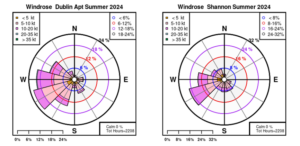
Dublin Airport, Co Dublin and Shannon Airport, Co Clare: Wind Roses for Summer 2024
The full report is available here (choose Summer on drop down menu for month) or the PDF is available here
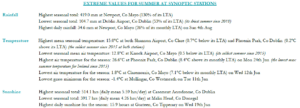
Summer 2024 extreme values at synoptic stations
*Issued by Met Éireann on Wednesday 4th September 2024. This report is based on available preliminary data from 25 principal weather stations operated by Met Éireann. Synoptic station data is midnight to midnight UTC. Long-Term Averages (LTAs) and “average” refer to the period 1981-2010 unless stated. A rain day is a day on which 0.2 mm or more of rainfall is measured. A wet day is a day with 1.0 mm or more of rainfall. A dull day is a day with less than 0.5 hours of sunshine. A very wet day is a day with 10.0 mm or more of rainfall. Climatological dry periods – An absolute drought is a period of 15 or more consecutive days to none of which is credited 0.2 mm or more of precipitation. A partial drought is a period of at least 29 consecutive days, the mean daily rainfall of which does not exceed 0.2 mm. A dry spell is a period of 15 or more consecutive days to none of which is credited 1.0 mm or more of precipitation (i.e. daily tot < 1.0 mm). A heatwave occurs where there are 5 consecutive days or more with maximum temperature over 25°C (that is, a daily maximum screen air temperature > 25° C). The Island of Ireland dataset is 125 years long and runs between 1900 and 2023. For this dataset the long term averages from the 1961-1990 reference period are used for comparison as is standard for long-term climate change assessments. *Sunshine data is from the Autosol Network. LTAs for these sites are currently not used for comparison purposes. For more information, contact Met Éireann at 01-8064200 or e-mail: enq@met.ie